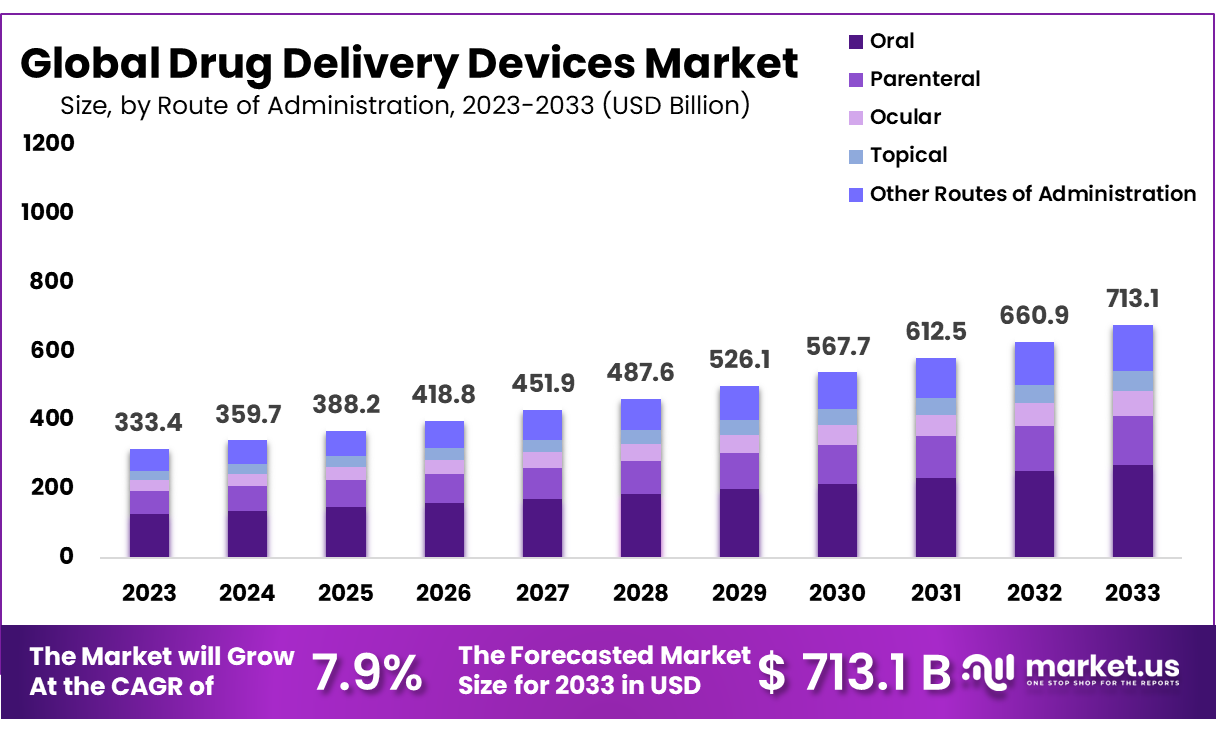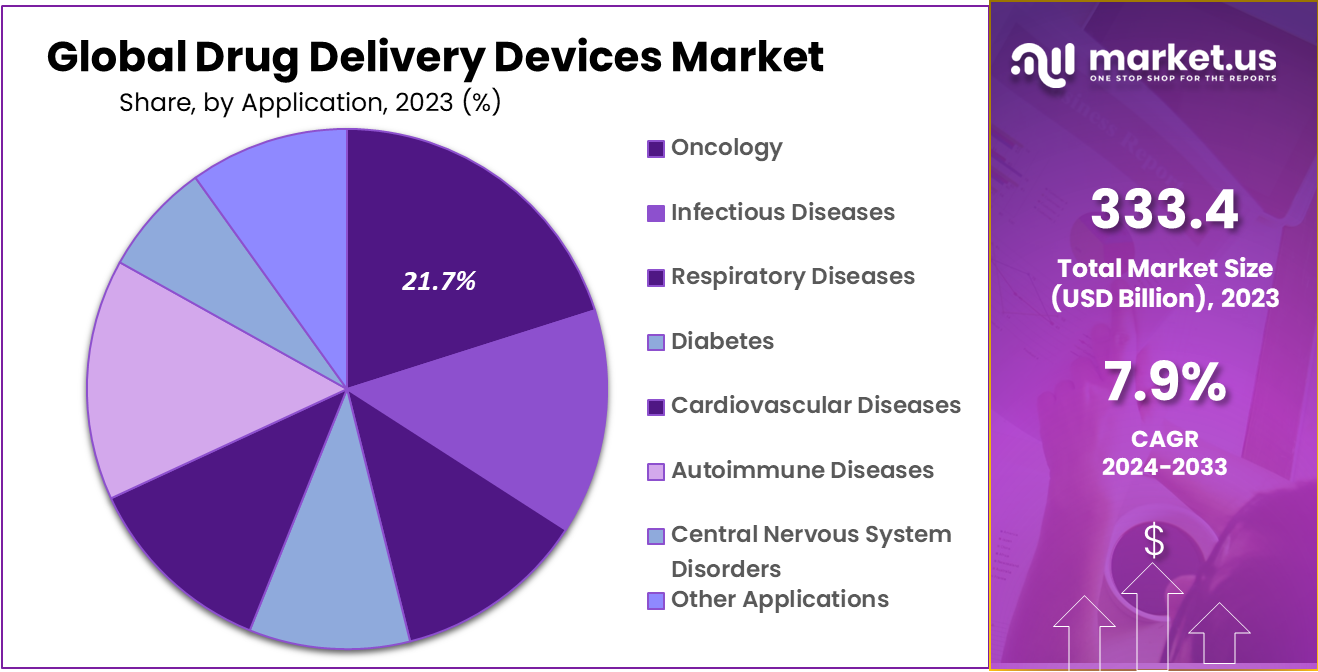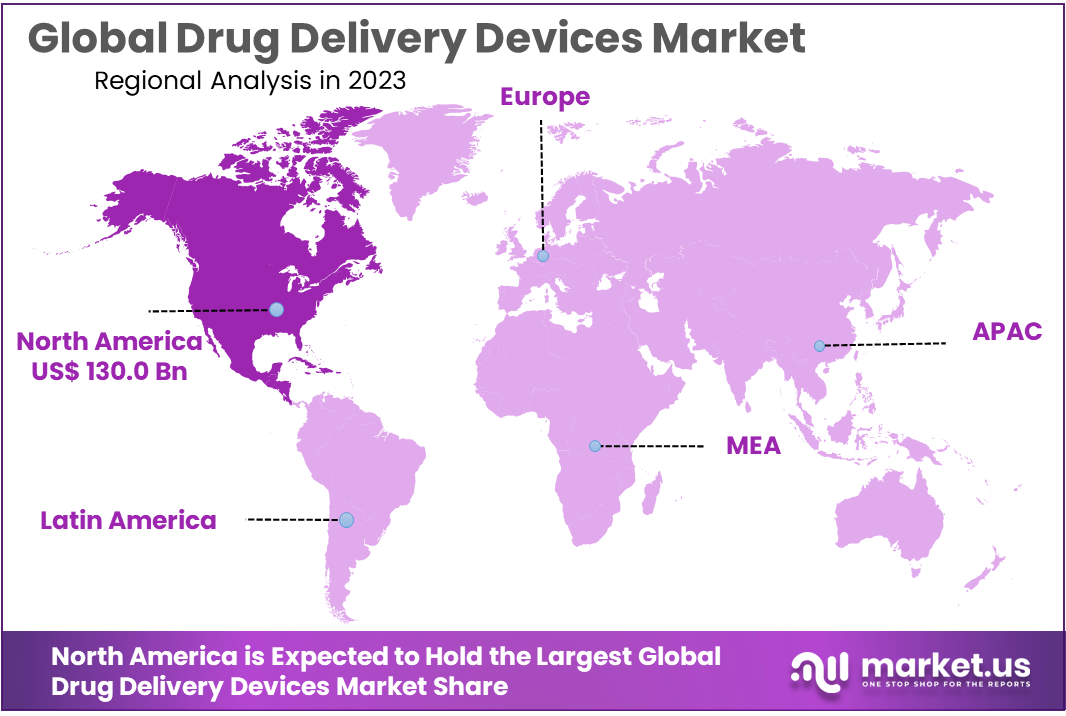Global Drug Delivery Devices Market By Route of Administration (Oral, Inhalation, and Other Route of Administration), By Vehicle (Micelle, Hydrogel, Liposome, and Other Vehicles), By Application (Oncology, Respiratory Diseases, Cardiovascular Diseases, and Other Applications) By End-Use (Diagnostic Centres, Hospitals, Home Care Settings, and Other End-Uses), By Region and Companies - Industry Segment Outlook, Market Assessment, Competition Scenario, Trends and Forecast 2024-2033
- Published date: Nov 2023
- Report ID: 19228
- Number of Pages: 275
- Format:
- keyboard_arrow_up
Quick Navigation
Market Overview
The Global Drug Delivery Devices Market size is expected to be worth around USD 713.1 Billion by 2033, from USD 333.4 Billion in 2023, growing at a CAGR of 7.9% during the forecast period from 2024 to 2033.
Drug delivery devices are not like traditional drugs. They’re better because they can precisely deliver medicines inside the body. This helps patients get the most out of their treatment. The drug delivery field is growing fast. People are learning more about these new drug delivery technologies. Governments are supporting them, and companies are investing in making better ways to deliver medicines.
The “Drug Delivery Devices” report explain about these new technologies. It looks at how they work and what they’re used for in treating diseases. It also explains how each device is designed and used.
Market growth will be driven by the increasing adoption of advanced technology to effectively deliver the drug to the target location. These devices optimize the drug’s presence at the target site, reducing the chance of side effects. This allows for a reduction in side effects as well as dose. This helps reduce the price of the product by reducing active pharmaceutical ingredients.

*Actual Numbers Might Vary In The Final Report
Key Takeaways
- Drug Delivery Devices Market size is expected to be worth around USD 713.1 Billion by 2033.
- Precision and Effectiveness: Drug delivery devices have advanced quickly over the past years in terms of precision and effectiveness for drug administration.
- Targeted Delivery: These devices are created for precise targeting of tissues and cells to maximize patient benefits.
- Government Support: Successful government initiatives are spurring on innovative drug delivery technologies to flourish.
- Research and Development: Increased investments in research and development have resulted in groundbreaking innovations for drug delivery platforms.
- In 2023, North America dominated the market with over 39% revenue share.
- Opportunities Await in Pharmaceutical Drug Delivery Market: Companies developing innovative pharmaceutical drug delivery products or systems have the chance to seize lucrative opportunities within this lucrative industry.
Route of Administration Analysis
In 2023, the Oral Route of Administration was the most popular choice for drug delivery, securing a substantial 38% share of the market. This highlights the preference for oral drug delivery methods. The pharmaceutical industry is putting a lot of effort into making drug delivery more precise and efficient. They are looking to deliver medicines directly to where they are needed in the body.
The market can be segmented by route of administration into oral, intradermal, transdermal, and injectable. The intradermal, subcutaneous, and intravenous routes are also available. The oral route of administration accounted for the largest percentage in 2023, and it is expected to continue growing at a rapid pace over the forecast period.
There are many dosage options for oral drug delivery, such as solutions, capsules, syrups, tablets, and suspensions. This includes tablets and films. Oral administration is preferred due to its safety, simplicity, cost, and stability. For patients suffering from pulmonary conditions such as asthma or Chronic Obstructive Pulmonary Disorder (COPD), inhalation drug delivery systems are preferable.
The growth of this market will be driven by factors like the rising prevalence of respiratory diseases and technological advancements in inhalation delivery devices such as inhalers and nebulizers. The fastest growth rate for the injectable route is anticipated during the forecast period. The demand for injectable drugs has increased with the introduction of pen injectors and prefilled syringes. Market growth is being driven by polymers and other materials for syringes that are inert to most chemicals.
Application Analysis
Oncology, infectious disease, respiratory diseases, and diabetes are the main segments of this market. Endocrine disorders and ophthalmic conditions are also included. In 2023, the biggest market share went to diabetes treatment devices in the application segment. This is due to diabetes’s increasing prevalence. The adoption of diabetes drug delivery devices will be influenced by an increase in diabetes cases.
Due to increasing cancer prevalence around the world, the oncology segment held a substantial share of the market. This segment is expected to grow moderately over the forecast period. In the United States, there were approximately 2 million new cancer cases in 2023. Liposomal and albumin drug delivery devices are the two main types used in oncology.
In 2023, the field of Oncology led the way, holding a significant 21.7% share in the drug delivery market. This shows that a major portion of drug delivery efforts is focused on cancer treatment.
The Central Nervous System Disorders (CNS), the segment will experience the fastest growth rate in the forecast period. This segment is expected to grow at a faster rate due to increasing numbers of neurological disorders, such as Parkinson’s, Hunter’s, Alzheimer’s, and brain tumors. To improve the treatment of these neurological conditions, new drug delivery systems are being developed for the CNS. These devices use receptor-ligand interaction and rational drug design to determine the effectiveness of drug delivery at the site.
Vehicles Analysis
The most popular drug delivery vehicle is the liposome. This segment is expected to grow because of its many advantages. The liposome drug delivery vehicle for liposomes is non-immunogenic. It is also biodegradable.
In 2023, hydrogels accounted for a large share of the market. This is due to their porosity, compatibility with an environment aqueous, and attractiveness as a drug delivery vehicle. Hydrogels can also be molded into many forms including microparticles and slabs, nanoparticles as well films, and coatings. These will help increase their adoption for various purposes. The hydrogels have the advantage of allowing for sustained drug delivery to the site. The segment’s growth is expected to be driven by controlled drug delivery via this vehicle.
The fastest expected growth in the forecast period will be for the nanoparticle drug delivery device. The forecast period will see a lot of research and growing interest in nanoparticles for drug delivery. The potential of nanoparticles as drug delivery vehicles is a promise for many applications. Polymeric nanoparticles can be prepared using both hydrophilic and hydrophobic blocks.
They are capable of encapsulating both hydrophobic as well as hydrophilic drugs. This structure helps to bind macromolecules, such as proteins, nucleic acids, or antibodies. The forecast period will see a significant increase in the use of nanoparticle drug delivery systems and their development.

End Use Analysis
According to end-user, the market is divided into hospitals and diagnostic centers, hospital ambulatory surgery centers/clinics as well as home care settings. Research centers, institutes, universities, and others are also included. Due to the increasing incidence of neurological disorders and cancer, hospitals accounted for the largest percentage in the End-Use segment, in 2023.
Hospitalized patients with different disorders need different drugs to treat. Different drug delivery devices can be used. Hospital-acquired Infection is expected to affect the adoption of drug delivery devices in hospitals. This could lead to a decrease in segment growth in the forecast period.
In 2023, it was reported that the Drug Delivery Devices Market was split into different sectors for end-users that included Diagnostic Centers, Ambulatory Surgery Clinics and Centers, Home Care Settings, and Hospitals. In particular, Hospitals accounted for the largest share at 31.8 percent which indicates their importance in the usage of drug delivery devices.
The market also saw a significant amount of share held by diagnostic centers in 2023. Many diagnostic centers focus on the development and adoption of novel drug delivery methods for accurately delivering drugs. Center for Drug Delivery and Nanomedicine (CDDN), focuses on the collection of existing expertise in biomedical sciences research and material for creating a Nanomedicine program and interdisciplinary drugs delivery. The main goal of the center is to improve drug delivery and understand how drugs work.
The fastest expected growth rate for the home care setting segment will be during the forecast period. This segment is expected to grow due to a number of factors, including the growing number of hospital-acquired illnesses, high costs, and longer wait times at hospitals. This trend is driving self-administration to increase the number of treatments in home care settings, as opposed to hospitals and other diagnostic centers.
Key Market Segments
Route of Administration
- Oral
- Inhalation
- Parenteral
- Ocular
- Topical
- Other Routes of Administration
Application
- Oncology
- Infectious Diseases
- Respiratory Diseases
- Diabetes
- Cardiovascular Diseases
- Autoimmune Diseases
- Central Nervous System Disorders
- Other Applications
Vehicle
- Hydrogel
- Micelle
- Dendrimer
- Nanoparticle
- Liposome
- Scaffold
- Mesoporous Material
- Niosomes
End-use
- Diagnostic Centers
- Hospital
- Ambulatory Surgery Centers/Clinics
- Home Care Settings
- Other End-Uses
Driver
Increasing prevalence is one major driver for their prevalence.
Drug delivery devices market growth can be attributed to many factors, including rising chronic disease prevalence rates, an aging population, technological innovations and growing healthcare expenditure. With cancer, diabetes and cardiovascular conditions increasing in prevalence rates there has been an increased need for efficient drug delivery solutions – drug delivery devices provide effective yet easy ways of administering long-term treatments effectively and conveniently.
Restriction
Strict Regulatory Requirements
Drug delivery devices face several obstacles on their journey to market success, including high development and manufacturing costs, stringent regulatory requirements, patient compliance issues, and competition from existing drug delivery methods. Drug delivery devices require significant investments in research, development, and manufacturing which in turn leads to higher production and market introduction costs. Regulators such as the FDA conduct thorough evaluations before authorizing new products on the market, making their introduction more time-consuming than necessary and delaying patient adoption of innovative devices on store shelves.
Opportunity
New developments in biologics and personalized medicine
Opportunities for Drug Delivery Device Manufacturers desfasoarbments in biologics and personalized medicine have created opportunities for manufacturers of drug delivery device solutions, particularly innovative drug delivery technologies that accommodate complex therapies that often necessitate special delivery methods. But Pricing and Reimbursement issues could hinder such breakthrough technologies from becoming reality. Essentially these two fields represent promising markets where there could be breakthrough innovations and lucrative revenue for delivery device makers alike.
Challenge
Pricing and Reimbursement Issues
Navigating the drug delivery devices market presents many obstacles for manufacturers. Manufacturers must navigate complex cost-effectiveness analysis conducted by health authorities that requires evidence of improved patient outcomes and cost savings with resource-intensive economic analyses, pricing pressure from stakeholders such as government agencies and insurers and pressure from different pricing models are just additional complications, forcing manufacturers to either accept smaller profit margins or change pricing strategies in order to remain competitive in an ever-evolving Market.
Regional Analysis
North America had the largest market share of 39% due to its presence of major players and the increasing adoption of drug delivery systems. The region’s market growth will also be supported by increased awareness about the benefits of drug delivery systems. Market growth is expected to be aided by increased product approvals in countries like the U.S. Aptar Pharma received FDA approval to use its nasal drug delivery system.
Europe accounted for a substantial share of the global market share in 2023 and is expected to grow at a moderate speed. Major market players in the region have access to huge markets because of their developed economies and favorable regulatory frameworks. The Asia Pacific is expected to have the highest growth rate due to its high economic growth. Additionally, the large patient base in countries like India, China, Japan, and China is leading to increased adoption of drug delivery technology by many end-users. Different drug delivery devices are being used in Japan for specific drug types.

Drug Delivery Devices Market Region *Actual Numbers Might Vary In The Final Report
Key Regions and Countries
- North America
- US
- Canada
- Mexico
- Europe
- Germany
- UK
- France
- Italy
- Russia
- Spain
- Rest of Europe
- APAC
- China
- Japan
- South Korea
- India
- Rest of Asia-Pacific
- South America
- Brazil
- Argentina
- Rest of South America
- MEA
- GCC
- South Africa
- Israel
- Rest of MEA
Key Players Analysis
Market players are seeking strategic alliances to expand their product range through partnerships and collaborations. DelSiTech and Bayer, for example, signed a technology licensing agreement to jointly develop and market innovative delivery technology in the area of ophthalmology. SMC Ltd., for its expanded product portfolio, announced the acquisition of Oval Medical Technologies Ltd. The deal included the addition of Oval Medical Technologies Ltd.’s advanced auto-injectors. The market will grow if there are more alliances to develop drug delivery devices.
Маrkеt Кеу Рlауеrѕ
- Pfizer, Inc.
- F. Hoffmann-La Roche Ltd
- Johnson and Johnson Private Ltd
- Novartis AG
- Teleflex Medical
- Bayer AG
- Becton, Dickinson and Company
- Baxter
- Abbott
Recent Developments
January 2023: Abbott introduces FreeStyle Libre 3, an advanced continuous glucose monitoring (CGM) system featuring an upgraded sensor and long wear time of 14 days, designed specifically to give those living with diabetes more convenient and accurate ways to monitor their blood glucose levels.
June 2023: Pfizer receives FDA approval of Vyndaqel, an oral therapy developed specifically to address transthyretin amyloidosis (ATTR). Vyndaqel works to stabilize transthyretin protein to stop it aggregating into amyloid deposits that damage organs and tissues, such as ATTR.
August 2023: FDA Approves First Refillable Wearable Insulin Pump System The Omnipod 5 insulin pump system, available exclusively through CVS pharmacies, allows patients to monitor and control insulin use remotely via smartphone app – providing more convenience for diabetes management than ever. This refillable device could improve diabetes care significantly for many.
Report Scope
Report Features Description Market Value (2023) USD 333.4 Billion Forecast Revenue (2033) USD 713.1 Billion CAGR (2024-2033) 7.9 % Base Year for Estimation 2023 Historic Period 2017-2022 Forecast Period 2024-2033 Report Coverage Revenue Forecast, Market Dynamics, Competitive Landscape, Recent Developments Segments Covered Route of Administration(Oral, Inhalation, Parenteral, Ocular, Topical, Other Routes of Administration)Application, Oncology, Infectious Diseases, Respiratory Diseases, Diabetes, Cardiovascular Diseases, Autoimmune Diseases, Central Nervous System Disorders, Other Applications, Vehicle(Hydrogel, Micelle, Dendrimer, Nanoparticle, Liposome, Scaffold, Mesoporous Material, Niosomes)End-use(Diagnostic Centers, Ambulatory Surgery Centers/Clinics, Home Care Settings, Other End-Uses) Regional Analysis North America-US, Canada, Mexico;Europe-Germany, UK, France, Italy, Russia, Spain, Rest of Europe;APAC-China, Japan, South Korea, India, Rest of Asia-Pacific;South America-Brazil, Argentina, Rest of South America;MEA-GCC, South Africa, Israel, Rest of MEA Competitive Landscape Pfizer, Inc., F. Hoffmann-La Roche Ltd, Johnson and Johnson Private Ltd, Novartis AG, Teleflex Medical, Bayer AG, Becton, Dickinson and Company, Baxter, Abbott and other Players. Customization Scope Customization for segments, region/country-level will be provided. Moreover, additional customization can be done based on the requirements. Purchase Options We have three licenses to opt for: Single User License, Multi-User License (Up to 5 Users), Corporate Use License (Unlimited User and Printable PDF) Frequently Asked Questions (FAQ)
What is the Drug Delivery Devices Market?The Drug Delivery Devices Market is a segment of the healthcare industry focused on the development and manufacturing of devices used to administer drugs to patients, ensuring precise and efficient delivery.
How big is the Drug Delivery Devices Market?The global Drug Delivery Devices Market size was estimated at USD 333.4 Billion in 2023 and is expected to reach USD 713.1 Billion in 2033.
What is the Drug Delivery Devices Market growth?The global Drug Delivery Devices Market is expected to grow at a compound annual growth rate of 7.9%. From 2024 To 2033
Who are the key companies/players in the Drug Delivery Devices Market?Some of the key players in the Drug Delivery Devices Markets are Pfizer, Inc., F. Hoffmann-La Roche Ltd, Johnson and Johnson Private Ltd, Novartis AG, Teleflex Medical, Bayer AG, Becton, Dickinson and Company, Baxter, Abbott and other Players.
What are the key drivers of the Drug Delivery Devices Market?Key drivers include the rising prevalence of chronic diseases, technological advancements, the need for patient-friendly drug administration, and the growth of the pharmaceutical industry.
What types of drug delivery devices are available in the market?Drug delivery devices include inhalers, insulin pens, syringes, auto-injectors, infusion pumps, and transdermal patches, among others.
How does the market benefit patients and healthcare providers?Drug delivery devices enhance treatment efficacy, improve patient compliance, reduce side effects, and offer more convenient and precise drug administration, benefitting both patients and healthcare providers.
 Drug Delivery Devices MarketPublished date: Nov 2023add_shopping_cartBuy Now get_appDownload Sample
Drug Delivery Devices MarketPublished date: Nov 2023add_shopping_cartBuy Now get_appDownload Sample - Pfizer, Inc.
- F. Hoffmann-La Roche Ltd
- Johnson and Johnson Private Ltd
- Novartis AG Company Profile
- Teleflex Medical
- Bayer AG Company Profile
- Becton, Dickinson and Company
- Baxter International Inc Company Profile
- Abbott Laboratories
- settingsSettings
Our Clients
| Single User $4,599 $3,499 USD / per unit save 24% | Multi User $5,999 $4,299 USD / per unit save 28% | Corporate User $7,299 $4,999 USD / per unit save 32% | |
|---|---|---|---|
| e-Access | |||
| Report Library Access | |||
| Data Set (Excel) | |||
| Company Profile Library Access | |||
| Interactive Dashboard | |||
| Free Custumization | No | up to 10 hrs work | up to 30 hrs work |
| Accessibility | 1 User | 2-5 User | Unlimited |
| Analyst Support | up to 20 hrs | up to 40 hrs | up to 50 hrs |
| Benefit | Up to 20% off on next purchase | Up to 25% off on next purchase | Up to 30% off on next purchase |
| Buy Now ($ 3,499) | Buy Now ($ 4,299) | Buy Now ($ 4,999) |












